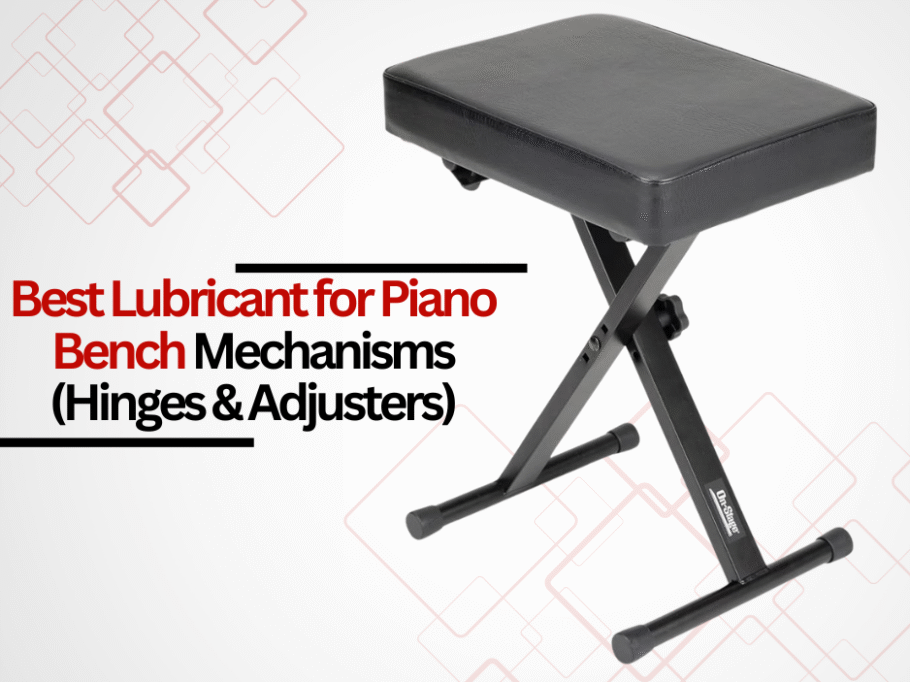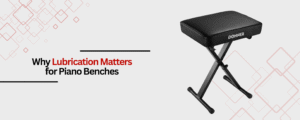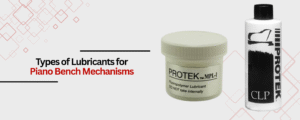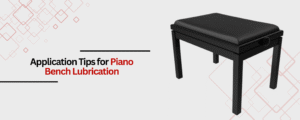Piano benches, especially those with adjustable mechanisms, are subject to frequent movement and mechanical stress. Over time, hinges and adjusters may begin to squeak, stick, or lose their smoothness. To maintain optimal performance and prolong the lifespan of your piano bench, proper lubrication of these moving parts is essential. This guide outlines the best lubricants for piano bench mechanisms and offers practical advice for their application.
Why Lubrication Matters for Piano Benches
Ensuring Smooth Operation:
Adjustable piano benches rely on metal and sometimes plastic components that move against each other. Without adequate lubrication, these parts can develop friction, leading to squeaks, resistance, or even mechanical failure. Regular lubrication ensures that height adjusters, hinges, and other moving parts operate smoothly and quietly.
Preventing Wear and Corrosion:
Metal parts are vulnerable to wear and corrosion, especially in environments with fluctuating humidity or temperature. The application of a suitable lubricant acts as a barrier, protecting components from rust and reducing long-term wear.
Types of Lubricants for Piano Bench Mechanisms
1. PTFE (Teflon) Powder
PTFE powder is highly recommended for piano mechanisms due to its dry, non-sticky nature. It provides excellent lubrication without attracting dust or dirt, making it ideal for hinges and adjusters where cleanliness is a priority. Application should be done with care, using a mask to avoid inhalation of fine particles.
2. Protek Lubricants
Protek products, including Protek CLP and Protek MPL-1, are formulated specifically for musical instruments. These lubricants are safe for use on wood, metal, and plastic and do not harm piano finishes. Protek MPL-1 is suitable for wood and metal parts, while Protek CLP is excellent for felt bushings and tiny pins. These lubricants do not run, dry out, or become ineffective over time, making them a preferred choice among piano technicians.
3. Graphite Lubricants
Graphite powder and graphite-based lubricants are also used for metal-to-metal contact points in piano benches. These products are effective at reducing friction and are commonly used in action parts and pedals. Care should be taken to apply graphite sparingly to avoid excess residue.
4. General Greases and Oils
For some bench mechanisms, a light application of general-purpose grease or oil may be suitable. However, it is recommended to use lubricants designed for musical instruments to avoid potential damage to wood or finishes.
Application Tips for Piano Bench Lubrication
Identifying Key Areas:
- Moving parts that benefit from lubrication include
- Height adjustment mechanisms
- Hinges on lift-top benches
- Sliding or rotating joints
- Screws and bolts involved in movement
How to Apply Lubricant:
- The mechanism should be cleaned of dust and debris before lubrication.
- A small brush, applicator, or needle oiler can be used to reach tight spaces and apply lubricant precisely.
- For PTFE or graphite powders, a gentle puff or brush is sufficient.
- After application, the mechanism should be moved through its range of motion to distribute the lubricant evenly.
Instead of spending on lubricants and repairs, find great deals on adjustable, squeak-free piano benches and upgrade your setup for lasting comfort and reliability.
Skip the hassle of maintenance—explore discounts on piano benches in a variety of styles and colors to refresh your music space effortlessly.
Frequency of Maintenance
Lubrication is typically recommended once a year or more frequently in dry or heavily used environments. Regular inspection for squeaks or resistance can help determine when reapplication is needed.
Safety and Precautions
- Only high-quality, instrument-safe lubricants should be used to avoid damage to wood, felt, or finishes.
- Excess lubricant should be wiped away to prevent buildup and dust attraction.
- When using powders, a mask is advised to avoid inhalation.
Conclusion
Proper lubrication of piano bench mechanisms is essential to maintain smooth, quiet, and reliable operation. PTFE powder, Protek lubricants, and graphite-based products are widely regarded as the best options for hinges and adjusters, offering long-lasting protection without compromising the integrity of the bench. Regular maintenance not only extends the life of your piano bench but also enhances your overall playing experience by ensuring silent and effortless adjustments.
By selecting the appropriate lubricant and following recommended application practices, the longevity and functionality of piano bench mechanisms can be preserved, supporting both comfort and performance in any musical setting.




